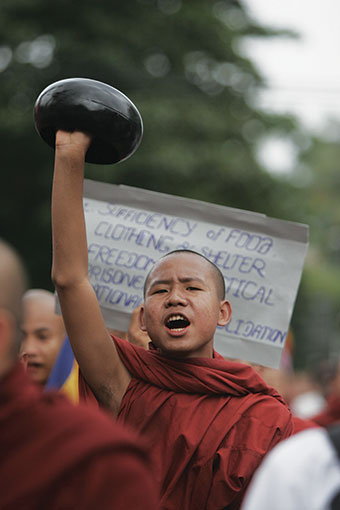Pictures of Burma

Law Eh Soe’s photojournalism at CEPA Gallery
An iconic photo of a young Buddhist monk raising his right arm and shouting during a protest march during the Burmese Saffron Revolution (so-called for the red-orange hue of the monk’s robes) is part of the CEPA exhibit of the work of Law Eh Soe, a Burmese photojournalist and current political refugee from Burma now living in Buffalo. In his upraised hand, the young monk is holding his alms bowl upside down as a symbol of civil disobedience refusal to acquiesce in harsh economic policies—one resulting in a sudden 66 percent rise in fuel prices—by the military junta government. The picture was somehow transmitted to an outside news agency and was published in newspapers and other media worldwide. Which put Law in imminent mortal danger, if the military junta forces had been able to locate and capture him. Instead, soon afterwards he escaped from Burma and eventually came to the United States and Buffalo.
Publicizing Burma’s internal problems to the outside world was considered a capital offense by the junta. Another of Law’s photos, of another protest scene, shows an assemblage of monks in what looks like a kind of sit-down strike in the middle of a street, while junta troops gather in the background, off to the side, and in the middle ground between the gathering troops and the monks, a Japanese photojournalist tending his camera, ready to photograph the impending confrontation. It’s the last known image of the Japanese photographer, of him not by him. Minutes later, he was killed by the soldiers during the melee. Law again barely managed to escape a similar fate.
A gripping documentary video about Law and his interesting life and work, called Click in Fear, was shown at the exhibit opening and is also viewable on YouTube. The video touches on ethical dilemmas of the photojournalism trade, particularly in politically troubled places and situations such as Burma in recent years. Of the photo of the young monk that went out worldwide, Law says, “I can’t feel happy about it, because I don’t know where this monk is now.”
In an emotional interview toward the end of the video, Law says, “I’m in a safe place now, but the people in my pictures were arrested and put in prison. I feel responsible for them, and knowing that I used their photos but ran away.”
As for running away, if he had stayed in Burma, more than likely he would have been killed. Government troops raided a house where he had been hiding, just after he moved out, moving around to avoid arrest. Eventually, on the advice of friends, heading for the border. Though with misgivings. In another interview he spoke about his actual departure from Burma. As he approached the border, he said, “I was shedding tears…I thought maybe I was being a coward, running to another country.” But he said before he left, “Monks came and prayed for me. They told me very simply, ‘Law, please never feel sad. Please go to where you need to. You have done enough here, so please go forward…’”
Law said he intends to return to Burma some day, as an American citizen. At present, he is working as an interpreter, but said he hopes to study for a fine arts degree at UB.
The CEPA show is divided roughly into two parts, two kinds of photos, those related to the Saffron Revolution and political protest, and photos of the people and the country. The people and country photos present a vivid account of peasant life on the land and particularly in relation to the Irrawaddy, Burma’s broad main river.
A few photos in neither of the above categories are of Burmese community activities in Buffalo, including a wedding and a general communal celebration featuring plentiful traditional costume and food and dance that was held at Lafayette High School. The Burmese represent the most recent wave of ethnic immigration to Buffalo. The total number of Burmese here currently is about 6,000. Law said most of the Burmese in Buffalo, like himself, fled Burma because of the political situation there.
The CEPA exhibit is presented in conjunction with the International Institute of Buffalo. It continues until June 9.
blog comments powered by Disqus|
Issue Navigation> Issue Index > v11n21 (week of Thursday, May 24) > Pictures of Burma This Week's Issue • Artvoice Daily • Artvoice TV • Events Calendar • Classifieds |









 Current Issue
Current Issue